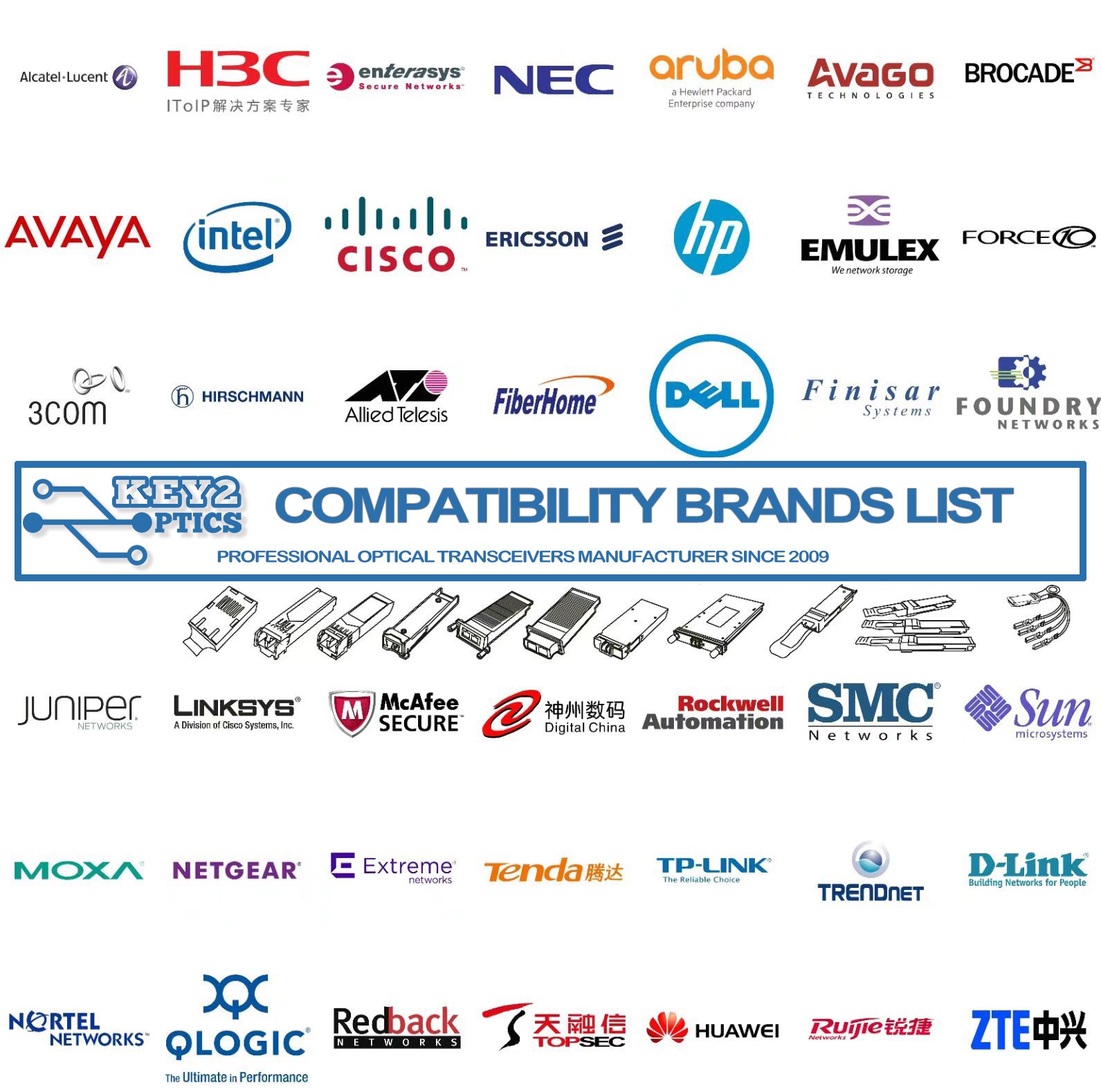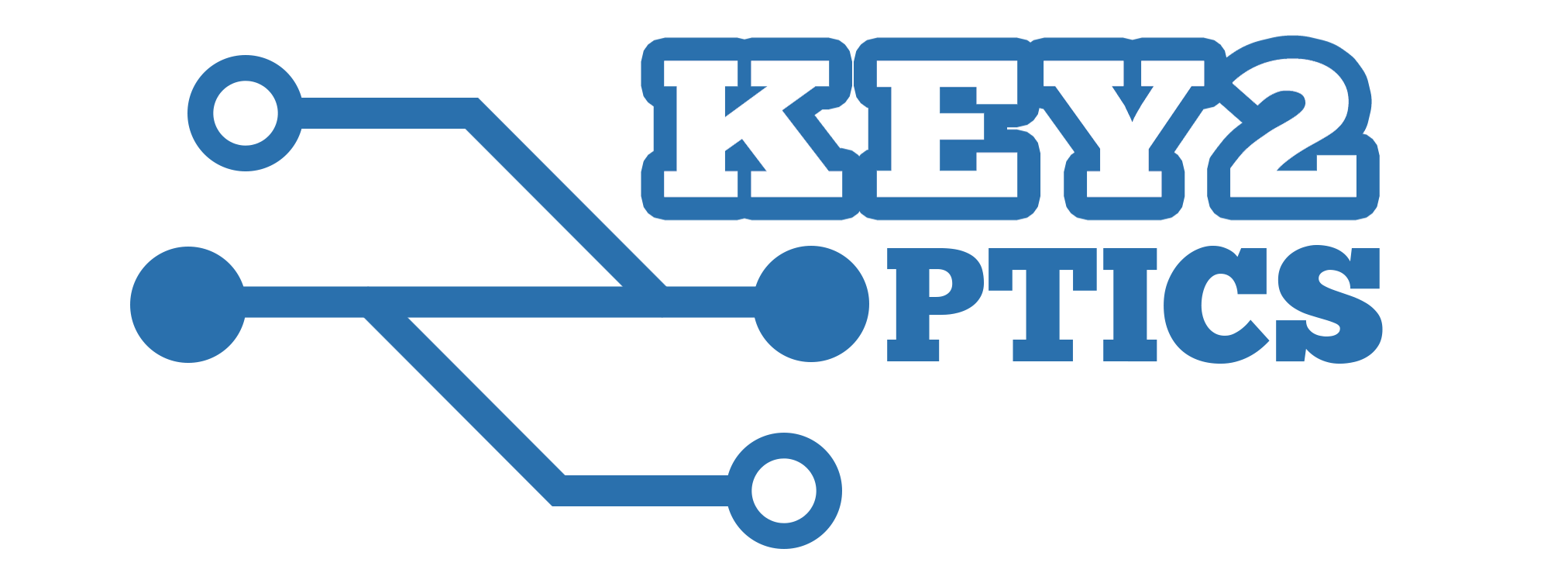Questions:
- Can your optical module work on Cisco, Juniper, Arista, or other brands’ network devices?
- I want to know what is the difference between the FHD, FHX, FHU, and FHZ.
- Do the transceivers have industry standard certifications like CE, FCC, RoHS, and UL?
- Why should I trust Key2Optics compatible transceivers?
- What kinds of custom choices are offered in Key2 Optics?
- Passive CWDM vs DWDM – Which to choose?
- What are the compatible brands of our transceivers?
- What is ROADM/OADM?
- DWDM CWDM in ROADM?
- What is different? SFP vs SFP+?
- Are SFP modules universal?
- Are optical cables directional?
- What is an optical link module?
Product FAQ
Can your optical module work on Cisco, Juniper, Arista, or other brands’ network devices?
Our optical module, AOC, and DAC can work on any brand’s network devices, the only difference is we need to change the different ‘firmware’ to match different brands and models, please tell us what types of devices and models numbers you will install our optical module, we will flash the exact firmware for you.
We have a list of compatible devices from different brands, you can contact your sales account manager for this document. You can check the compatible list below.
I want to know what is the difference between the FHD, FHX, FHU, and FHZ.
Key2 Optics could provide FHD, FHX, FHU, and FHZ four series products for structured cabling solution demands. FHD High-Density Series is a versatile solution in multiple sizes (1U/2U/4U) and styles for building backbones, data centers, and enterprise applications. FHX Ultra HD Series is ideal for service providers, central office facilities, large enterprises,s and cloud data centers. FHU Series is designed to connect where fast deployment and simple maintenance are critical. FHZ Premium Ultra HD Series enables to provide scalability to increase density as business demands evolve.
Do the transceivers have industry standard certifications like CE, FCC, RoHS, and UL?
Most of the transceivers are CE and FCC certified, some are RoHS certified, and we are working on the UL certification, and we will have all the certifications compliant such as EMC, MIL ready in the near future.
Why should I trust Key2Optics compatible transceivers?
Besides the price advantage, we have compared to branded transceivers, Key2Optics-compatible transceivers also maintain the same performance and reliability. To satisfy our customers’ needs for high performance, all of our transceivers are tested multiple times in mainstream original brand switches in our test center before being shipped out.
What kinds of custom choices are offered in Key2 Optics?
As for customized direct attach cables and active optical cables, as well as all our transceiver products, Key2 Optics offers regular custom choices such as compatibility, cable length, cable color, operating temperature, label pattern, label colors and etc. What’s more, Key2 Optics welcomes any inquiry for customized products and solutions for all needs and specifications.
Passive CWDM vs DWDM – Which to choose?
Generally, CWDM offers a convenient and cost-efficient solution for a short distance (like 70km), low capacity, and up to 10G rate per channel. While DWDM supports long-haul applications with speed protocols of up to 100G/200G per channel.
What are the compatible brands of our transceivers?
We support almost all the brands of network devices in the market, please find the list as follows, if there is any brand not listed please contact our support ([email protected]).

What is ROADM/OADM? (Wiki)
A reconfigurable optical add-drop multiplexer (ROADM) is a form of optical add-drop multiplexer that adds the ability to remotely switch traffic from a wavelength-division multiplexing (WDM) system at the wavelength layer. This is achieved through the use of a wavelength-selective switching module. This allows an individual or multiple wavelengths carrying data channels to be added and/or dropped from a transport fiber without the need to convert the signals on all of the WDM channels to electronic signals and back again to optical signals.
The main advantages of the ROADM are:
- The planning of the entire bandwidth assignment need not be carried out during the initial deployment of a system. The configuration can be done as and when required without affecting traffic already passing the ROADM.
- ROADM allows for remote configuration and reconfiguration.
- In ROADM, as it is not clear beforehand where a signal can be potentially routed, there is a necessity of power balancing of these signals. ROADMs allow for automatic power balancing.
DWDM CWDM in ROADM?
OADM functionality originally appeared in dense long-haul wavelength division multiplexing (DWDM) equipment, but by 2005, it began to appear in metro optical systems because of the need to build out major metropolitan networks in order to deal with the traffic driven by the increasing demand for packet-based services.
The switching or reconfiguration functions of a ROADM can be achieved using a variety of switching technologies including microelectromechanical systems (MEMS), liquid crystal, thermo optic and beam-steering switches in planar waveguide circuits, and tunable optical filter technology.
What is different? SFP vs SFP+?
SFP is Small Form-factor Pluggable interface for 100M~1G SFP optical transceivers, the maximum speed can only reach 1.25Gbps; SFP+ is a higher speed version of the SFP interface, which brings a higher speed up to 10Gbps rate.
SFP and SFP+ are compatible with each other, but not for speed, that is, SFP cannot reach 10G speed when in an SFP+ interface, and SFP+ can only reach 10G speed rate when insert into an SFP interface.
Are SFP modules universal?
No, it is not universal to all SFP interfaces from different brands, because some brands like Cisco, can only use their own SFP modules because of the ‘code’ barrier. However, we can customize our SFP module to make it compatible with those brands, and make them work perfectly as their original SFP module products. Please refer to our post: (Are ALL SFP Modules Compatible?) for more details.
Are optical cables directional?
Optical cables such as patch cords, or high-speed AOC cables (active optical cables) are non-directional. However, if you use some duplex fiber (esp. multi-mode fiber), in SFP modules or optical transceivers, you have to crossover the two fibers. That is, to connect the transmission port to one end and the receiver port to another end.

What is an optical link module?
An optical Link Module is the alias of an Optical Transceiver, SFP Module, or SFP Transceiver.

